Equations of motion for a particle
We start with some basic definitions and physical laws.
1 Definition of a particle
A `Particle’ is a point mass at some position in space. It can move about, but has no characteristic orientation or rotational inertia. It is characterized by its mass.
Examples of applications where you might choose to idealize part of a system as a particle include:
1. Calculating the orbit of a satellite 


2. A molecular dynamic simulation, where you wish to calculate the motion of individual atoms in a material. Most of the mass of an atom is usually concentrated in a very small region (the nucleus) in comparison to inter-atomic spacing. It has negligible rotational inertia. This approach is also sometimes used to model entire molecules, but rotational inertia can be important in this case.
Obviously, if you choose to idealize an object as a particle, you will only be able to calculate its position. Its orientation or rotation cannot be computed.
2 Position, velocity, acceleration relations for a particle (Cartesian coordinates)
 In most practical applications we are interested in the position or the velocity (or speed) of the particle as a function of time. But
In most practical applications we are interested in the position or the velocity (or speed) of the particle as a function of time. But
Position vector: In most of the problems we solve in this course, we will specify the position of a particle using the Cartesian components of its position vector with respect to a convenient origin. This means
1. We choose three, mutually perpendicular, fixed directions in space. The three directions are described by unit vectors 



2. We choose a convenient point to use as origin.
3. The position vector (relative to the origin) is then specified by the three distances (x,y,z) shown in the figure.
In dynamics problems, all three components can be functions of time.
Velocity vector: By definition, the velocity is the derivative of the position vector with respect to time (following the usual machinery of calculus)

Velocity is a vector, and can therefore be expressed in terms of its Cartesian components
You can visualize a velocity vector as follows
· The direction of the vector is parallel to the direction of motion
· The magnitude of the vector 



When both position and velocity vectors are expressed in terms Cartesian components, it is simple to calculate the velocity from the position vector. For this case, the basis vectors 




This is really three equations 



Acceleration vector: The acceleration is the derivative of the velocity vector with respect to time; or, equivalently, the second derivative of the position vector with respect to time.

The acceleration is a vector, with Cartesian representation 



Like velocity, acceleration has magnitude and direction. Sometimes it may be possible to visualize an acceleration vector 


The relations between Cartesian components of position, velocity and acceleration are

3 Examples using position-velocity-acceleration relations
It is important for you to be comfortable with calculating velocity and acceleration from the position vector of a particle. You will need to do this in nearly every problem we solve. In this section we provide a few examples. Each example gives a set of formulas that will be useful in practical applications.
Example 1: Constant acceleration along a straight line. There are many examples where an object moves along a straight line, with constant acceleration. Examples include free fall near the surface of a planet (without air resistance), the initial stages of the acceleration of a car, or and aircraft during takeoff roll, or a spacecraft during blastoff.
Suppose that
The particle moves parallel to a unit vector i
The particle has constant acceleration, with magnitude a
At time 







At time 







The position, velocity acceleration vectors are then
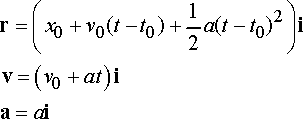


Verify for yourself that the position, velocity and acceleration (i) have the correct values at t=0 and (ii) are related by the correct expressions (i.e. differentiate the position and show that you get the correct expression for the velocity, and differentiate the velocity to show that you get the correct expression for the acceleration).
HEALTH WARNING: These results can only be used if the acceleration is constant. In many problems acceleration is a function of time, or position 





 Example 2: Simple Harmonic Motion: The vibration of a very simple spring-mass system is an example of simple harmonic motion.
Example 2: Simple Harmonic Motion: The vibration of a very simple spring-mass system is an example of simple harmonic motion.
In simple harmonic motion (i) the particle moves along a straight line; and (ii) the position, velocity and acceleration are all trigonometric functions of time.
For example, the position vector of the mass might be given by

Here 







Harmonic vibrations are also often characterized by the frequency of vibration:
· The frequency in cycles per second (or Hertz) is related to the period by f=1/T
· The angular frequency is related to the period by 



The motion is plotted in the figure on the right.
The velocity and acceleration can be calculated by differentiating the position, as follows
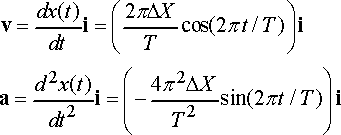


Note that:
· The velocity and acceleration are also harmonic, and have the same period and frequency as the displacement.
· If you know the frequency, and amplitude and of either the displacement, velocity, or acceleration, you can immediately calculate the amplitudes of the other two. For example, if 












 Example 3: Motion at constant speed around a circular path Circular motion is also very common
Example 3: Motion at constant speed around a circular path Circular motion is also very common
The simplest way to make an object move at constant speed along a circular path is to attach it to the end of a shaft (see the figure), and then rotate the shaft at a constant angular rate. Then, notice that
· The angle 











· The speed of the particle is related to 















For this example the position vector is
The velocity can be calculated by differentiating the position vector.
Here, we have used the chain rule of differentiation, and noted that 



The acceleration vector follows as
Note that
(i) The magnitude of the velocity is 







(ii) The magnitude of the acceleration is 







We can write these mathematically as

 Example 4: More general motion around a circular path
Example 4: More general motion around a circular path
We next look at more general circular motion, where the particle still moves around a circular path, but does not move at constant speed. The angle 



We can write down some useful scalar relations:
· Angular rate: 



· Angular acceleration 




· Speed 



· Rate of change of speed 




We can now calculate vector velocities and accelerations
The velocity can be calculated by differentiating the position vector.
The acceleration vector follows as


It is often more convenient to re-write these in terms of the unit vectors n and t normal and tangent to the circular path, noting that 








These are the famous circular motion formulas that you might have seen in physics class.
4 Velocity and acceleration in normal-tangential and cylindrical polar coordinates.
In some cases it is helpful to use special basis vectors to write down velocity and acceleration vectors, instead of a fixed {i,j,k} basis. If you see that this approach can be used to quickly solve a problem 








Normal-tangential coordinates for particles moving along a prescribed planar path
 In some problems, you might know the particle speed, and the x,y coordinates of the path (a car traveling along a road is a good example). In this case it is often easiest to use normal-tangentialcoordinates to describe forces and motion.
In some problems, you might know the particle speed, and the x,y coordinates of the path (a car traveling along a road is a good example). In this case it is often easiest to use normal-tangentialcoordinates to describe forces and motion.
For this purpose we
· Introduce two unit vectors n and t, with t pointing tangent to the path and n pointing normal to the path, towards the center of curvature
· Introduce the radius of curvature of the path R.
Then:
(i) The direction of the velocity vector of a particle is tangent to its path. The magnitude of the velocity vector is equal to the speed.
(ii) The acceleration vector can be constructed by adding two components:
· the component of acceleration tangent to the particle’s path is equal 



· The component of acceleration perpendicular to the path (towards the center of curvature) is equal to 



Mathematically 




To use these formulas, you need to be able to find n, t, and R. Often you can just write these down. If you happen to know the parametric equation of the path (i.e. the x,y coordinates are known in terms of some variable 





The sign of n should be selected so that

The radius of curvature can be computed from
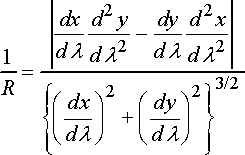

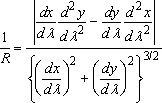
The radius of curvature is always positive.
 Example: Design speed limit for a curvy road: As a consulting firm specializing in highway design, we have been asked to develop a design formula that can be used to calculate the speed limit for cars that travel along a curvy road.
Example: Design speed limit for a curvy road: As a consulting firm specializing in highway design, we have been asked to develop a design formula that can be used to calculate the speed limit for cars that travel along a curvy road.
The following procedure will be used:
· The curvy road will be approximated as a sine wave 






· Vehicles will be assumed to travel at constant speed V around the path 


· For safety, the magnitude of the acceleration of the car at any point along the path must be less than 0.2g, where g is the gravitational acceleration. (Again, note that constant speed does not mean constant acceleration, because the car’s direction is changing with time).
Our goal, then, is to calculate a formula for the magnitude of the acceleration in terms of V, A and L. The result can be used to deduce a formula for the speed limit.
Calcluation:
We can solve this problem quickly using normal-tangential coordinates. Since the speed is constant, the acceleration vector is

The position vector is 



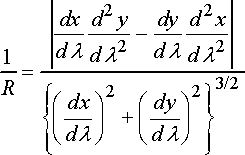

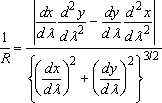
Note that x acts as the parameter 










and the acceleration is

We are interested in the magnitude of the acceleration…

We see from this that the car has the biggest acceleration when 



The formula for the speed limit is therefore 



Now we send in a bill for a big consulting fee…
Polar coordinates for particles moving in a plane
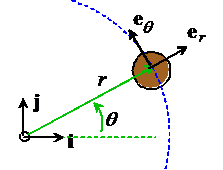 When solving problems involving central forces (forces that attract particles towards a fixed point) it is often convenient to describe motion using polar coordinates.
When solving problems involving central forces (forces that attract particles towards a fixed point) it is often convenient to describe motion using polar coordinates.
Polar coordinates are related to x,y coordinates through
Suppose that the position of a particle is specified by its ‘polar coordinates’ 












The velocity and acceleration of the particle can then be expressed as



You can derive these results very easily by writing down the position vector of the particle in the {i,j} basis in terms of 



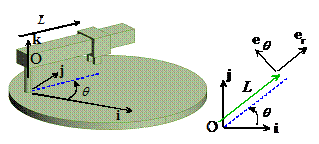 Example The robotic manipulator shown in the figure rotates with constant angular speed
Example The robotic manipulator shown in the figure rotates with constant angular speed
We can simply write down the acceleration vector, using polar coordinates. We identify 




3.1.5 Measuring position, velocity and acceleration
If you are designing a control system, you will need some way to detect the motion of the system you are trying to control. A vast array of different sensors is available for you to choose from: see for example the list athttp://www.sensorland.com/HowPage001.html . A very short list of common sensors is given below
the motion of the system you are trying to control. A vast array of different sensors is available for you to choose from: see for example the list athttp://www.sensorland.com/HowPage001.html . A very short list of common sensors is given below
 the motion of the system you are trying to control. A vast array of different sensors is available for you to choose from: see for example the list athttp://www.sensorland.com/HowPage001.html . A very short list of common sensors is given below
the motion of the system you are trying to control. A vast array of different sensors is available for you to choose from: see for example the list athttp://www.sensorland.com/HowPage001.html . A very short list of common sensors is given below
1. GPS 


2.  Optical or radio frequency position sensing
Optical or radio frequency position sensing 


 Optical or radio frequency position sensing
Optical or radio frequency position sensing
3. Capacitative displacement sensing 


4. Electromagnetic displacement sensing 


5. Radar velocity sensing 


6. Inertial accelerometers: measure accelerations by detecting the deflection of a spring acting on a mass.
Accelerometers are also often used to construct an ‘inertial platform,’ which uses gyroscopes to maintain a fixed orientation in space, and has three accelerometers that can detect motion in three mutually perpendicular directions. These accelerations can then be integrated to determine the position. They are used in aircraft, marine applications, and space vehicles where GPS cannot be used.
6 Newton’s laws of motion for a particle
1. m denote the mass of the particle
2. F denote the resultant force acting on the particle (as a vector)
3. a denote the acceleration of the particle (again, as a vector). Then
Occasionally, we use a particle idealization to model systems which, strictly speaking, are not particles. These are:
1. A large mass, which moves without rotation (e.g. a car moving along a straight line)
2. A single particle which is attached to a rigid frame with negligible mass (e.g. a person on a bicycle)
In these cases it may be necessary to consider the moments acting on the mass (or frame) in order to calculate unknown reaction forces.
1. For a large mass which moves without rotation, the resultant moment of external forces about the center of mass must vanish.
2. For a particle attached to a massless frame, the resultant moment of external forces acting on the frame about the particle must vanish.
It is very important to take moments about the correct point in dynamics problems! Forgetting this is the most common reason to screw up a dynamics problem…
If you need to solve a problem where more than one particle is attached to a massless frame, you have to draw a separate free body diagram for each particle, and for the frame. The particles must obey Newton 











The Newtonian Inertial Frame.
When we use Newton
For engineering calculations, this usually poses no difficulty. If we are solving problems involving terrestrial motion over short distances compared with the earth’s radius, we simply take a point on the earth’s surface as fixed, and take three directions relative to the earth’s surface to be fixed. If we are solving problems involving motion in space near the earth, or modeling weather, we take the center of the earth as a fixed point, (or for more complex calculations the center of the sun); and choose axes to have a fixed direction relative to nearby stars.
But in reality, an unambiguous inertial frame does not exist. We can only describe the relative motion of the mass in the universe, not its absolute motion. The general theory of relativity addresses this problem 


Newton

No comments:
Post a Comment